Louis Arthur Ducos du Hauron
Louis Arthur Ducos du Hauron (8 December 1837 – 31 August 1920) was a French pioneer of color photography.
Louis Arthur Ducos du Hauron | |
|---|---|
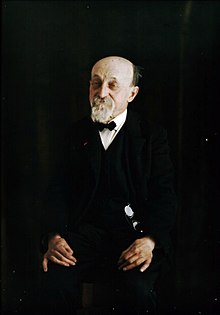 Louis Ducos du Hauron, photographed on an Autochrome plate in 1910. The Lumière Brothers' Autochrome process was based on one of the several color photography methods he patented in 1868. | |
| Born | (1837-12-08)8 December 1837 Langon, Gironde, France |
| Died | 31 August 1920(1920-08-31) (aged 82) Agen, Lot-et-Garonne, France |
| Known for | Color photography |
Personal life
He was born in Langon, Gironde and died in Agen.
Photography
After writing an unpublished paper setting forth his basic concepts in 1862, he worked on developing practical processes for color photography on the three-color principle, using both additive and subtractive methods.[1][2][3] In 1868 he patented his ideas (French Patent No. 83061) and in 1869 he published them in Les couleurs en photographie, solution du problème. The discovery of dye sensitization by Hermann Wilhelm Vogel in 1873 greatly facilitated the initial three-color analysis on which all of Ducos de Hauron's methods depended.[4]
The most widely reproduced of his surviving color photographs is the View of Agen, an 1877 image of a landscape in southern France, printed by the subtractive assembly method he pioneered. Several different photographs of the view from his attic window, one dated 1874, also survive, as do later views taken in Algeria, still life subjects, reproductions of paintings and art prints, and at least two portraits of uncertain date.
In 1891, he introduced the anaglyph stereoscopic print, the "red and blue glasses" type of 3-D print. Although others had earlier applied the same principle to drawings or used it to project images onto a screen, he was the first to reproduce stereoscopic photographs in the convenient form of anaglyph prints on paper.[5]
Gallery
-
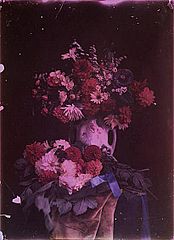 Still life with dahlias, 1869
Still life with dahlias, 1869 -
 Color print made from three direct photograms, 1869 or 1870
Color print made from three direct photograms, 1869 or 1870 -
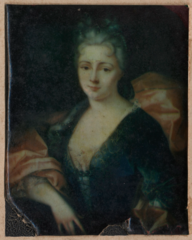 Reproduction of an oil painting, 1873
Reproduction of an oil painting, 1873 -
 View of Agen, 1875.
View of Agen, 1875. -
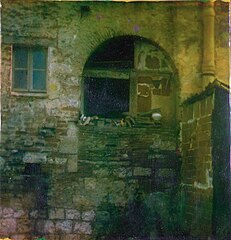 "A hovel in our neighbourhood", Agen, dated 14 March 1877.
"A hovel in our neighbourhood", Agen, dated 14 March 1877. -
 View of Agen, France, showing the St. Caprais cathedral, 1877. Heliochrome (multilayer dichromated pigmented gelatin process). George Eastman House
View of Agen, France, showing the St. Caprais cathedral, 1877. Heliochrome (multilayer dichromated pigmented gelatin process). George Eastman House -
 A later 20th century print of the Agen photograph made from the original 1877 negatives. George Eastman House
A later 20th century print of the Agen photograph made from the original 1877 negatives. George Eastman House -
 Garden view in Agen, 1877
Garden view in Agen, 1877 -
 View of Agen, looking southwest, circa 1870s
View of Agen, looking southwest, circa 1870s -
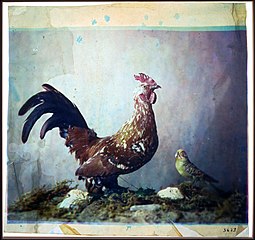 Mounted birds, 1879
Mounted birds, 1879 -
 View of Algeria, 1880s or 1890s
View of Algeria, 1880s or 1890s
References
- ^ "Lumière Jubilee". Time. 18 November 1935.
The idea was patented as early as 1864 [sic—actually 1868] by a now forgotten Frenchman named Louis Arthur Ducos du Hauron.
- ^ Solbert, Oscar N.; Beaumont, Newhall; Card, James G., eds. (April 1952). "Forgotten Pioneers IV: Louis Ducos Du Hauron (1837–1920)" (PDF). Image, Journal of Photography of George Eastman House. 1 (6). Rochester, N.Y.: International Museum of Photography at George Eastman House Inc.: 2. Archived from the original (PDF) on 4 March 2016. Retrieved 21 June 2014.
- ^ Dr. Carl Finch (1920). "Louis Arthur Ducos du Hauron, In Memoriam". Photo-Era, The American Journal of Photography. Vol. 45. New England Photo Era Publishing Company. pp. 281–282.
- ^ Newhall, Beaumont (May 1954). "An 1877 Color Photograph" (PDF). Image, Journal of Photography of George Eastman House. III (5). Rochester, N.Y.: International Museum of Photography at George Eastman House Inc.: 33–34. Archived from the original (PDF) on 20 July 2014. Retrieved 15 July 2014. Prior to Vogel's discovery, Ducos du Hauron photographed the green and orange-red-filtered components by making use of a color sensitization phenomenon discovered by Edmond Becquerel in 1840, but very long exposures in the camera were required.
- ^ "A History of Photography, by Robert Leggat: ANAGLYPHS"
Further reading
- Coe, Brian (1978). Colour Photography: The First Hundred Years, 1840–1940. London: Ash & Grant. ISBN 978-0-904069-24-2.
External links
 Media related to Louis Ducos du Hauron at Wikimedia Commons
Media related to Louis Ducos du Hauron at Wikimedia Commons
- v
- t
- e
- Antoine Samuel Adam-Salomon
- Marie-Alexandre Alophe
- Édouard Baldus
- Louis-Auguste Bisson
- Adolphe Braun
- Auguste Hippolyte Collard
- André-Adolphe-Eugène Disdéri
- Geneviève Élisabeth Disdéri
- Jules Duboscq
- Jean-Baptiste Frénet
- Henri Le Secq
- Charles Marville
- Auguste Mestral
- Eugène Piot
- Alphonse Louis Poitevin
- Henri Victor Regnault
- Ernest Eugène Appert
- Étienne-Prosper Berne-Bellecour
- Félix Bonfils
- Léon Crémière
- John Beasley Greene
- Louis Arthur Ducos du Hauron
- Étienne-Jules Marey
- Pierre Petit
- Camille Silvy
- Hippolyte Arnoux
- Paul Boyer
 | This article about a French photographer is a stub. You can help Wikipedia by expanding it. |
- v
- t
- e





















